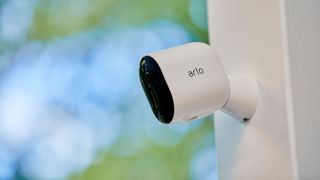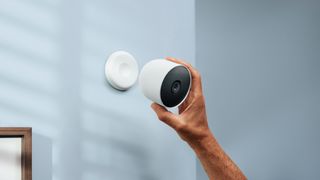Where is the best place to install my home security cameras?
Deciding where to fit them is easier than you think

The best home security cameras ensure you can keep an eye of you property even when you’re not around, and they’re often heavily discounted on Black Friday and Cyber Monday, so you may be considering buying one very soon.
But owning a home security camera is just half the battle, knowing exactly where to install itis crucial. Naturally, you will want to choose a location that gives every camera the best possible view. But it isn’t always as simple as that, and sometimes compromises will need to be made.
For example, wireless cameras may seem to have more flexibility, but you’ll need to make sure they’re easily accessible when their batteries need charging, while some wired cameras need to be connected to existing wiring rather than plugged into a socket.
Want to get your hands on one of the best home security cameras now, rather than reading on to discover the best place to install one is? Then check out these great deals for some of the best on the market right now.
So, where should I install an outdoor home security camera?
First of all, do you own the property or are you renting? We ask this first because renters will likely be unable to install outdoor security cameras without their landlord’s permission, so make sure you check your tenancy agreement first. If your front door has a peephole, consider the Ring Door View - this video doorbell attaches to the peephole of your front door without the need for any screws. You could also look at installing indoor cameras with a view out of a window.
For property owners, things are simpler. You should begin by installing a camera with a good view of the front door. According to security camera company Reolink, 34% of burglars enter properties through the front door, with 23% opting for a first-floor window, 22% go for the back door, and 9% break-in through the garage, so covering off these areas is crucial.
You also need to consider external factors like lighting. Locate your camera in a position that avoids backlighting and lens flare caused by the sun, reflections, and other nearby light sources. These can cause recordings to be washed out and over-exposed, making them too bright to be of any use. Also make sure the camera is protected from direct sunlight, as this can also overexpose and potentially ruin your security footage.
Get daily insight, inspiration and deals in your inbox
Get the hottest deals available in your inbox plus news, reviews, opinion, analysis and more from the TechRadar team.
The camera should be high enough to be out of reach, but still in a position where it can be installed and accessed with a ladder, or via an upstairs window. Position the camera too high, however, and key details like faces and vehicle registration plates might not be clearly visible. On a similar note, check the field of view of the camera you intend to buy. Some are narrower than others, and while a wider view is often preferable, this can distort the image by making objects and the distances between them seem larger than they really are.
Next, check for the strength of your Wi-Fi network. Most of today’s smart security cameras connect to the internet using Wi-Fi, and because they transmit large Full HD (sometimes even 4K) video files, a fast and stable connection is crucial. This will be a case of trial-and-error, experimenting with the camera in the desired position, then checking footage is recorded correctly. Ideally, you should try this while using your Wi-Fi for high-bandwidth tasks like 4K video streaming and online gaming at the same time, to make sure the camera remains connected and stable no matter what else is going on.
If Wi-Fi connectivity is a concern, consider home security cameras that work over Ethernet instead. However, this comes with the added complexity of routing cables to your cameras and potentially drilling holes through walls or window frames to get them connected.
Speaking of cables, some cameras are somewhat lacking out of the box. The Nest Cam (battery), which is designed for outdoor and indoor use, comes with a cable that is just 3.3 feet / 1m long and can only be used indoors. If you want to use it outside without removing it from the wall every time it needs charging, you’ll need to invest in an additional weatherproof cable - Nest offers 16.4 feet / 5m or 33 feet / 10m options.
With these technical issues taken care of, you should now look at the privacy concerns a security camera could raise. Your camera should not have a view of property that does not belong to you.
To further help, smart security cameras can be set to not record certain portions of their view, helping you block out property that doesn’t belong to you. It might be worth explaining this to your neighbors and showing them the view your camera records. Lastly on privacy, if you live in an apartment block you should make sure that a doorbell camera doesn’t have a direct view into someone else’s property; this can be a particular concern in narrow hallways.
- How to use home security camera and will it replace a video doorbell?
- Find out which is the right home security camera for you in Ring vs Arlo
- We ask a former burglar: do smart security cameras really deter crime?

What about indoor security cameras?
Given most burglars enter through the front door, it’s worthwhile installing an indoor camera with a good view of it. And, unlike exterior cameras that you might want to hide, it could be a good idea to make the indoor camera visible. That way, a burglar breaking in will be greeted with the sight of a camera that has already recorded their crime, potentially causing them to flee before stealing anything.
Indoor cameras are usually powered from a wall outlet instead of a battery, so you will need to route cables up walls to get the best views of doors and windows. Placing a camera on a high shelf and tilting the lens down can help improve the view, but not all indoor cameras can adjust their viewing angle.
Burglars are likely to seek out high-value items. This will vary for each household, but if you keep jewelry in the bedroom, or own a particularly expensive ornament or piece of art, a camera pointed there is a good idea. And remember, with their two-way audio connections these cameras can also be used as a handy way to check in on pets and children while you’re away.
- Check out the best cheap home security camera deals
Alistair Charlton is a freelance technology and automotive journalist based in London. His career began with a stint of work experience at TechRadar back in 2010, before gaining a journalism degree and working in the industry ever since. A lifelong car and tech enthusiast, Alistair writes for a wide range of publications across the consumer technology and automotive sectors. As well as reviewing dash cams for TechRadar, he also has bylines at Wired, T3, Forbes, Stuff, The Independent, SlashGear and Grand Designs Magazine, among others.

